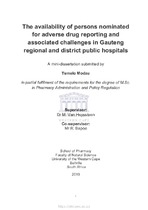| dc.description.abstract | Background and Objectives: The reporting of adverse drug reactions (ADRs) is a major public health necessity. It is estimated that only six to 10 percent of all ADRs are reported worldwide. This number is far less than the actual cases of ADRs which occur in healthcare facilities. There appears to be lack of knowledge, awareness and willingness of healthcare professionals to report ADRs, which prompted some countries to nominate a person for ADR reporting in facilities. The objectives of this study were to ascertain which facilities had a nominated person or committee for ADR reporting, describe the knowledge and training of these individuals, describe the processes followed by the facilities for ADR reporting, determine the most commonly reported ADRs and causative drug classes, and, determine the factors which facilitate or hinder ADR reporting.
Method: This was an exploratory, multicenter study. A structured questionnaire with closed and open-ended questions was used for data collection. The study was conducted in Gauteng province, where stratified non-random sampling was used to collect data in the selected regional and district public hospitals.
Results: Six regional hospitals and five district hospitals participated in the study. Five (45.5%) of these hospitals had a person nominated for ADR reporting, of which all were pharmacists. All the respondents nominated for ADR reporting stated their knowledge and confidence in identification of ADRs as average and above. One (20%) of the nominated persons for ADR reporting did not have pharmacovigilance training. The reported number of ADRs over the past 12 months ranged between zero and 199. Only two (40%) of the hospitals with a nominated person for ADR reporting received feedback on the submitted reports from a committee.
Only one (16.7%) of the six hospitals that did not have a nominated person or committee for ADR reporting had plans to nominate a person for this function. ADR reporting in these hospitals were performed by the pharmacy that collated the identified ADRs into a report and distributed these to the Pharmacy and Therapeutics Committee (PTC) and South African Health Products Regulatory Authority (SAHPRA).
Only one hospital out of all the hospitals (n=11) did not use the national ADR reporting form and rather used an incident report. Out of all the participating hospitals, only two (18.2%) of the hospitals had an algorithm in place to assist with the identification of ADRs. The researcher went through the file where ADR reporting forms were kept for the past 12 months, and reported that the most commonly reported ADR type across participating facilities was allergic reactions such as rash and angioedema reported by eight of the facilities, followed by administration errors and quality issues each from three facilities. While the most frequently reported drug class associated with these ADRs included antiretrovirals (ARVs) and angiotensin converting enzyme (ACE) inhibitors reported at eight and six facilities, respectively.
The most common challenge to ADR reporting at participating facilities was non-reporting of ADRs, followed by fear of litigation and patient’s unwillingness. Although all the hospitals in this study had facility PTCs, only one hospital had a pharmacovigilance subcommittee and the others included ADRs as an agenda point of the PTC meetings.
Conclusion: Less than half of the facilities had a person nominated for ADR reporting. Pharmacists and the pharmacy were synonymous with ADR reporting as all nominated persons were pharmacists and in facilities were there were no nominated person, the responsible pharmacist was identified as the contact person for ADR reporting. Although all hospitals had PTCs, there was rarely a subcommittee dedicated to pharmacovigilance or ADR reporting, which culminated in a lack of feedback to healthcare workers that could promote it in the facility. Underreporting of ADRs by health care workers was the major challenge to effective ADR reporting as this function was considered to be too time consuming. | en_US |

